Besoins en nutriments des tomates
Les tomates ont des besoins constants en azote et en potassium tout au long de leur cycle de croissance. Toutefois, le rapport idéal entre ces deux éléments change en fonction du stade de développement de la plante. Fournir la bonne proportion est crucial pour une bonne croissance et un bon développement des fruits. Pour une qualité optimale des fruits et pour prévenir le problème courant de pourriture apicale (Blossom End Rot, BER), le calcium est un autre nutriment essentiel dans le programme nutritionnel de la tomate.
Azote (N)
La forme de l'azote joue un rôle important dans le rendement des tomates. Il est recommandé d'utiliser des engrais contenant un pourcentage élevé de nitrate, comme le nitrate de potassium. Les plantes cultivées avec des engrais à base d'ammonium ont tendance à avoir des rendements plus faibles et à subir plus de stress que celles qui ne reçoivent que du nitrate. En outre, l'ammonium rivalise avec l'absorption du calcium, de sorte que l'utilisation d'engrais à faible teneur en ammonium aide à prévenir les carences en calcium.
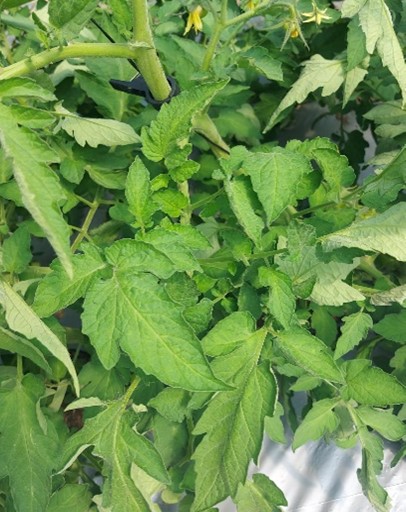
Carence en azote chez la tomate
Potassium (K)
Le potassium est essentiel pour une croissance et une qualité optimales des tomates. Le nitrate de potassium est la source recommandée car la forme nitrique facilite l'absorption du potassium par la plante. Des niveaux adéquats de potassium sont essentiels pour divers processus vitaux, notamment l'équilibre des charges électriques dans la plante, la régulation du métabolisme cellulaire et le contrôle de la pression osmotique. Ces fonctions contribuent à plusieurs avantages:
- eilleure tolérance à la sécheresse et réduction du flétrissement
- Meilleure résistance aux maladies
- Promotion du développement d'une couleur rouge éclatante et réduction des troubles de la couleur des fruits
- Teneur en matière sèche plus élevée dans les fruits
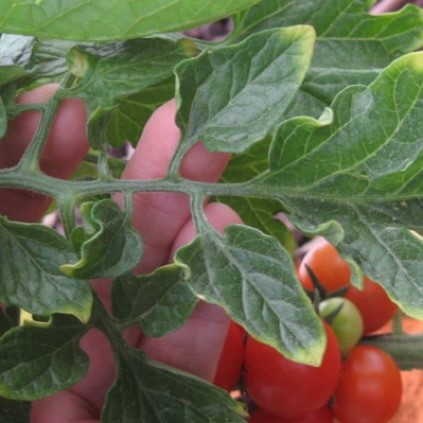
Carence en potassium chez la tomate
Calcium (Ca)
Le calcium joue un rôle essentiel dans la construction de parois cellulaires solides, permettant d'obtenir des fruits plus fermes et mieux formés. L'ion calcium est immobile dans la plante, ce qui signifie qu'il se déplace des racines vers les organes supérieurs uniquement dans le xylème.
Divers facteurs peuvent entraver l'absorption du calcium et conduire à la pourriture apicale (BER):
- Stress hydrique
- Stress salin dans la zone racinaire
- Températures élevées en conditions sèches
- Système racinaire peu développé
Une gestion minutieuse du calcium est cruciale dans ces conditions, notamment l'application combinée d'engrais calciques de Nutrigation™ (fertigation) et de pulvérisations foliaires. Il est également important de maintenir un rapport optimal Ca-Mg-K de 3-1-3 pour éviter la compétition entre ces éléments et assurer une absorption suffisante du calcium.
Voici quelques stratégies supplémentaires pour améliorer l'absorption du calcium et prévenir la pourriture apicale :
- Une bonne irrigation, en particulier lorsque le temps est chaud et sec.
- Irrigations nocturnes : le calcium est absorbé par la plante pendant la journée et est transféré aux feuilles. La nuit, lorsque la transpiration est faible, le calcium est transféré aux fruits.
- Choisir des variétés résistantes : certaines variétés de tomates sont plus sensibles que d'autres à la pourriture apicale.
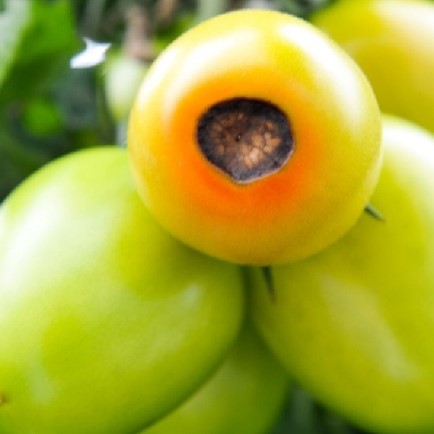
Pourriture apicale (Blossom End Rot, BER) - un trouble courant associé à une carence en calcium
Magnésium (Mg)
Le magnésium est essentiel à la santé des tomates (bien que seules les carences graves aient un impact sur la taille et le rendement des fruits). Ces carences se produisent généralement lorsque les températures du sol sont basses ou que l'irrigation est insuffisante. Cela empêche l'absorption du magnésium du sol. Si de telles conditions se présentent, l'application de pulvérisations foliaires de magnésium avec du nitrate de magnésium peut prévenir les carences importantes.
Bien que l'absorption du magnésium soit en concurrence avec le calcium et le potassium, le maintien d'un programme de nutrition équilibré prévient les carences et garantit une santé optimale des plantes.
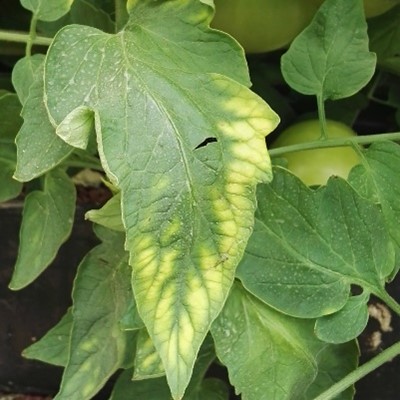
Carence en magnésium chez la tomate
Salinité
Des taux de salinité élevés dans le sol peuvent entraver la croissance des plants de tomates. Une conductivité électrique (CE) du sol supérieure à 2,5 dS/m (pâte saturée) peut entraîner une diminution des rendements.
Dans certaines conditions salines, le sodium entre en compétition avec l'absorption du potassium. Des niveaux élevés de chlorure peuvent également entraver l'absorption du nitrate. Ceci réduit le développement de la plante et la production de fruits. Dans de tels cas, les mesures correctives comprennent l'application d'une quantité importante de potassium, de nitrate d’azote et de calcium.
Il convient de noter que certaines variétés de tomates, comme les tomates cerises, peuvent tolérer une salinité plus élevée (CE supérieure à 4 dS/m). Dans ces variétés, la salinité peut même améliorer la concentration en sucre et prolonger la durée de conservation.
 | Développement végétatif La racine en développement requiert des niveaux élevés de phosphore (P). Un rapport N-P2O5-K2O de 1-1-1 est recommandé à ce stade. |
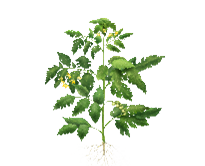 | Croissance végétative Le rapport N-P2O5-K2O recommandé à ce stade est de 1-1-1. |
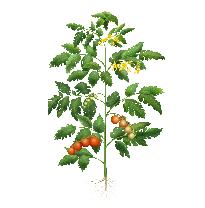 | De la floraison initiale à la nouaison Lors des processus de reproduction, la plante requiert de plus grandes quantités de potassium tandis que ses besoins en phosphore diminuent. Le rapport N-P2O5-K2O recommandé est désormais de 2-1-3. |
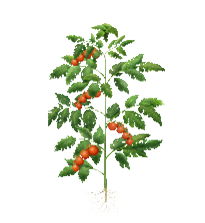 | Développement et maturation des fruits Les fruits en croissance créent une carence importante en potassium et l'absorption du potassium augmente en conséquence. L'équilibre N-P2O5-K2O passe à ce stade à 5-3-10. |
Voir les recommandations détaillées en matière de fertilisation.
Nutrition foliaire complémentaire
L'application foliaire de nutriments à des stades spécifiques du développement des cultures accroît les rendements et améliore la qualité. Pour stimuler la croissance végétative, il est conseillé de compléter la nutrition des racines par une application foliaire d'engrais avec un rappor N-P2O5-K2 de 1-1-1.
Aux stades de reproduction, il est recommandé d'assurer des niveaux adéquats de calcium par une application foliaire. Cela contribuera à prévenir le développement de la pourriture apicale.
En savoir plus sur les avantages de la nutrition foliaire






